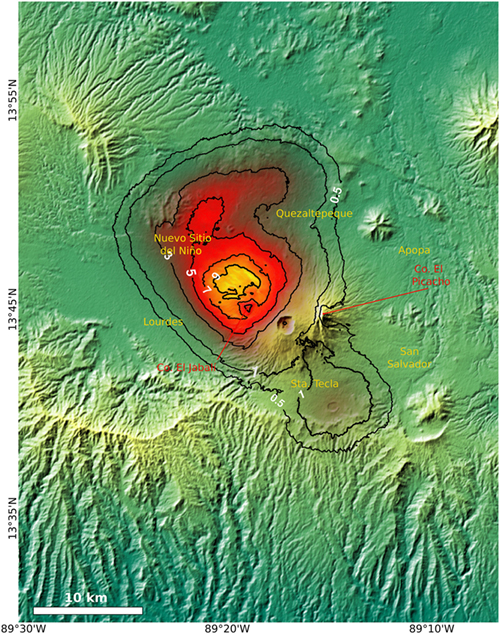Scenario-based probabilistic hazard assessment for explosive events at the San Salvador volcanic complex, El Salvador

Aravena A., A. Bevilacqua, A. Neri, P. Gabellini, D. Ferrés, D. Escobar, A. Aiuppa, R. Cioni (2023).
Journal of Volcanology and Geothermal Research, 438, https://doi.org/10.1016/j.jvolgeores.2023.107809
Abstract
We present a scenario-based, probabilistic hazard assessment for the San Salvador volcanic complex (SSVC), a volcanic field located in the vicinity of San Salvador that includes the El Boquerón stratovolcano and 25 monogenetic vents. We define a set of likely eruption scenarios for tephra fallout and pyroclastic density currents (PDCs). The eruption scenarios range from violent Strombolian eruptions with a significant uncertainty in source position to sub-Plinian and Plinian activity fed from the central cone. The adopted methodology is mainly based on numerical modeling using Tephra2 (adopting the software TephraProb) to study tephra fallout and the branching box model and the branching energy cone model (adopting the programs BoxMapProb 2.0 and ECMapProb 2.0) to describe inertial and frictional PDCs, respectively. Despite the dominant W-WSW-trending winds, numerical results show that Plinian eruptions at El Boquerón volcano are able to deposit thick tephra layers in the metropolitan area of San Salvador city, likely reaching mass loads of the order of 100 kg/m2 (conditional probability of 50%). The simulated sub-Plinian events highlight the seasonal influence of wind patterns. In fact, the conditional probability of significant tephra sedimentation in San Salvador city is strongly reduced when eruptions occur during the rainy season. Numerical modeling of violent Strombolian eruptions is performed considering uncertainty in vent position. Results show that the conditional probability of depositing tephra mass loads higher than 10 kg/m2 at a given point reaches a maximum value of ∼7% on the NW flank of the volcano, at about 8 km from the central crater. On the other hand, very low conditional probabilities (<1%) are obtained for San Salvador city for any relevant threshold (10 kg/m2 or more) of tephra mass load during violent Strombolian events. Regarding PDCs, results show that those produced during large-scale Plinian eruptions are able to invade significant areas of the volcano surroundings, including San Salvador city. PDCs generated from the partial collapse of a sub-Plinian eruption column exhibit maximum inundation probabilities on the N, W and S flanks of the volcano. Cerro El Picacho exerts a significant shield effect on the propagation of these PDCs, with low inundation probabilities for San Salvador city (<3%). Finally, coupling published vent opening probability maps and numerical modeling of small-scale PDCs yields maximum inundation probabilities on the NW flank of the volcano, reaching maximum conditional probabilities of the order of ∼10% and values of about 5% near the village of Nuevo Sitio del Niño.


Devi effettuare l'accesso per postare un commento.